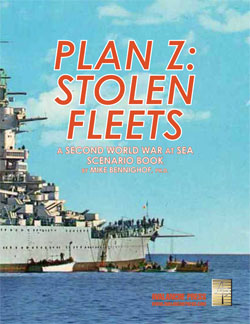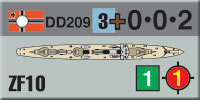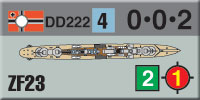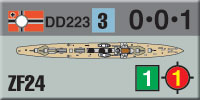| Stolen Fleets:
Captured French Destroyers
by Mike Bennighof, Ph.D.
March 2020
 France’s Marine Nationale ended the First World War with a force of small, worn-out destroyers of the “800-ton” type - useful for escort work, their primary task during the conflict, but out-gunned by the bigger new destroyers built by the Germans and Italians in the last year of the war. Afterwards they acquired an example of these huge destroyers when the 2,400-ton German “torpedo boat” S113 was transferred to France as a war reparation. France’s Marine Nationale ended the First World War with a force of small, worn-out destroyers of the “800-ton” type - useful for escort work, their primary task during the conflict, but out-gunned by the bigger new destroyers built by the Germans and Italians in the last year of the war. Afterwards they acquired an example of these huge destroyers when the 2,400-ton German “torpedo boat” S113 was transferred to France as a war reparation.
Re-named Amiral Sénès by the French, the boat served for sixteen years. She carried a small cruiser’s armament, with four 150mm (5.9-inch) guns and was very fast at 36 knots. By the time France fell to the Germans, she had been sunk as a gunnery target, but her design greatly influenced two decades of French destroyer construction.
The 1922 Naval Law saw a new fleet built around aircraft carriers, cruisers and destroyers. Those destroyers would be much larger than previous classes, and classed as contre-torpilleurs, resurrecting the old label of “torpedo-boat destroyers.” Many of them appear in Plan Z: Stolen Fleets; let’s have a look at them.
Beasts of Prey

The Chacal class, laid down in 1922, and the very similar Guépard, Aigle and Vauquelin classes which followed between 1927 and 1931, were about the same size as Amiral Sénès. They carried five 138mm (5.5-inch) guns in single mounts, six torpedo tubes (rather than the two of the ex-German boat; the Vauquelin class had seven tubes) and likewise were very fast, clocking 35.5 knots when new (the Vauquelins were slightly faster at 36 knots).
The four classes totaled 24 boats. Of those, four were sunk in 1940 fighting against the Germans, and four more in 1941 and 1942 defending Vichy French colonies against the Allies. One served the Free French throughout the war. Of the remaining 15, all were at Toulon in November 1942 when the French fleet was scuttled. Eleven of those were total losses, while the remaining four were either captured intact or in minimally damaged condition and turned over to the Royal Italian Navy.
We included thirteen of them in Plan Z: Stolen Fleets, and once refitted they’re a potent addition to the German destroyer force. Some would have been taken in Atlantic ports, and others at Toulon. Like the bigger ships, the Toulon boats would have been overhauled in Italian shipyards, but all to the same standard. Their French main armament has been replaced by German-made 128mm guns, and the torpedo tubes with German models as well. German electronics replace the French gear, but the French-made power plant - more reliable than the overly sophisticated engine rooms of German destroyers - remains intact.
The Fantastic Boat

The Le Fantasque class that followed remained at the same size with the same main armament, with seven torpedo tubes like the previous class. Where they differed radically was in their power plant, whose output leapt from 64,000 to 74,000 horsepower thanks to new-model turbines. Designed for 37 knots, they all exceeded 40 knots on trials and in service.
Once again the Marine Nationale built a class of six boats, completing them in 1935 and 1936. One was put out of action defending Vichy North Africa from the Allies and later stripped for spare parts. Four served the Free French, and one scuttled at Toulon. That last boat (L’Indomptable) appears in Stolen Fleets in German colors as ZF23, refitted like the previous class with German weapons and electronics. She’s still exceptionally fast, and unlike the German-built destroyers in the game is not subject to random unavailability due to maintenance troubles.
The Ultimate Destroyer

For the next class, the Marine Nationale tossed out the model completely and built what was in essence a small, unarmored and exceptionally fast cruiser. The Mogador class displaced just under 3,000 tons and had been designed to accompany the new Dunkerque class battle cruisers on missions in the North Atlantic. They were exceptionally stable boats even in heavy seas, and thanks to a cutting-edge high-pressure power plant they topped 43 knots on trials, exceeding 40 knots in service.
They carried eight 138mm guns in four twin gunhouses, mounts that gave trouble throughout their service life. Maximized for surface combat, they also had ten torpedo tubes.
The Marine Nationale laid down two boats in 1934 and commissioned them in 1939 following a year-long trials period. Both were scuttled in Toulon in November 1942. The French authorized three more in 1938, a fourth in 1939 and two more in 1940; none of these were laid down before France fell in June 1940.
The two completed boats, Mogador and Volta, appear in our Plan Z story serving the Free French. We included two more of their never-completed sisters in German colors, having been handed over the Brest as part of the armistice conditions. They’re refitted like the other big French destroyers, with twin gunhouses for 128mm guns used on later-model German destroyers replacing the 138mm mountings. The power plant remains the same, but the Germans add additional generator capacity for all of the electronics crammed aboard. The torpedo tubes and light anti-aircraft array are replaced by German models.
A Mighty Wind

The French also built a large class of destroyer-sized destroyers, laying down a dozen Bourrasque-class destroyers in 1923(all named for winds); two more would be built for the Polish Navy (also named for winds, but in Polish) in an inexperienced French yard amid a swirl of corruption. These boats displaced 1,500 tons and carried four 130mm guns with six torpedo tubes. They made 33 knots when new.
Of the dozen French boats, four were sunk during the 1940 campaign, three lost defending French North Africa from the Allies, and five survived to serve the Free French. Two of them serve the Free French in our Plan Z story line, and we included four more in Stolen Fleets in German colors. Like the bigger destroyers they’ve had their French 130mm guns replaced by German 128mm pieces and given up their torpedo tubes, light anti-aircraft weaponry and electronics for German models. They’re slower than German destroyers and no more capable than the small destroyers the Germans call torpedo boats, but like the larger destroyers they have the positive quality of mechanical reliability.
And those are the French destroyers that serve the Germans in Stolen Fleets. They’re among the most valuable additions, given the unreliable machinery of the German-built boats. The Germans also would have taken a number of obsolete ships including aging battleships, smaller warships and auxiliaries, but they’re not included here.
You can order Plan Z: Stolen Fleets right here.
Sign up for our newsletter right here. Your info will never be sold or transferred; we'll just use it to update you on new games and new offers.
Mike Bennighof is president of Avalanche Press and holds a doctorate in history from Emory University. A Fulbright Scholar and award-winning journalist, he has published over 100 books, games and articles on historical subjects.
He lives in Birmingham, Alabama with his wife, three children and his dog, Leopold.
|
